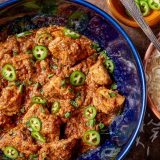Low and slow. If you’ve wondered what sets apart Pakistani and Indian cuisines, start there. The meat-heavy Pakistani diet favors slow cooking over low heat to extract big flavor. Vegetable-focused Indian cuisines speed things up. Of course, that’s a gross simplification.
Each country is home to innumerable cuisines, some more distinct than others. But the regions’ cooking writ large has such overlap—biryanis, curries, naan, samosas and kormas all ignore geopolitical lines—it’s easy to get confused.
Which is why Muneeze Khalid, my guide and the owner of a culinary school for women in Lahore, tried to simplify it for me. The most important difference, she explained, is the Pakistani devotion to bhunai.
“Bhunai! Bhunai! Bhunai!” she said, using the Hindi term that translates as roasting or frying, but is used colloquially to refer to building flavor with time and stirring. “With Pakistani food, we are more patient. We like taking time making our food.”
It’s why copious onions browned slowly in ghee form the backbone of so many dishes. But if rules are defined by exceptions, Pakistani cooking is no exception. Which is how I met Mohammed Sadiq.
Khalid insisted I try one of Pakistan’s rare speedy curries, chicken karahi, a rapid-fire dish in which tomatoes, chilies and spices cook down quickly to create a thick glaze that coats and flavors the meat.
Sadiq has been making chicken karahi for 14 years, most recently at Asli Fresh Tikka Shop in Lahore. His shop is fronted by six burners, each holding a shallow wok-like pan—called a karahi, for which the dish is named—their carbon steel burnished blue-black from the long flames that lick their sides.
Sadiq deftly managed them all, sloshing ingredients in one and out of another. The cooking began with tomatoes and red chilies, ample earthy garam masala—the country’s ubiquitous spice blend, often built from cloves, cumin, cinnamon, cardamom, black pepper and coriander—and many spoonfuls of pureed garlic and ginger.
The tomatoes and chilies broke down, reducing and thickening. There was plenty of stirring, but this was bhunai on fast forward. Before the sauce became too concentrated, Sadiq added the chicken, tender boneless strips and chunks.
As the sauce reduced, bubbling and caramelizing, the meat cooked in a flash. As the dish neared finish, Sadiq reached for a second round of some of the same ingredients—more ginger and garlic, more garam masala, more chilies. It’s a technique common to Pakistani (and Indian) cooking, using the same ingredients multiple times, each at a different point of cooking, which coaxes different flavors from each instance.
Off heat, a stir of yogurt added a creamy note to balance the chili heat and sweetly acidic tomatoes. Sopped up with hunks of naan pulled from a neighboring shop’s tandoor oven moments before, it was impressively flavorful, rich and balanced by the tomatoes, earthy spices and pops of heat.
For our version, we found we could streamline. Sadiq marinated his chicken in chilies and lemon, but we found the dish plenty flavorful without that step. We also learned from another chef to finish the dish with butter, not yogurt. But why choose? We loved both.
Chicken karahi may be an exception to Pakistan’s love of low and slow cooking, but it sacrificed nothing in its speed.
Pakistan’s Speedy Sweet-and-Savory Chicken Curry
J.M. Hirsch
March - April 2024

Get the Recipe
Pakistani Chicken Karahi (Spicy Tomato-Chicken Curry)
In Lahore, we learned to turn tomatoes and chilies into a tangy glaze
Photo: J.M. Hirsch







